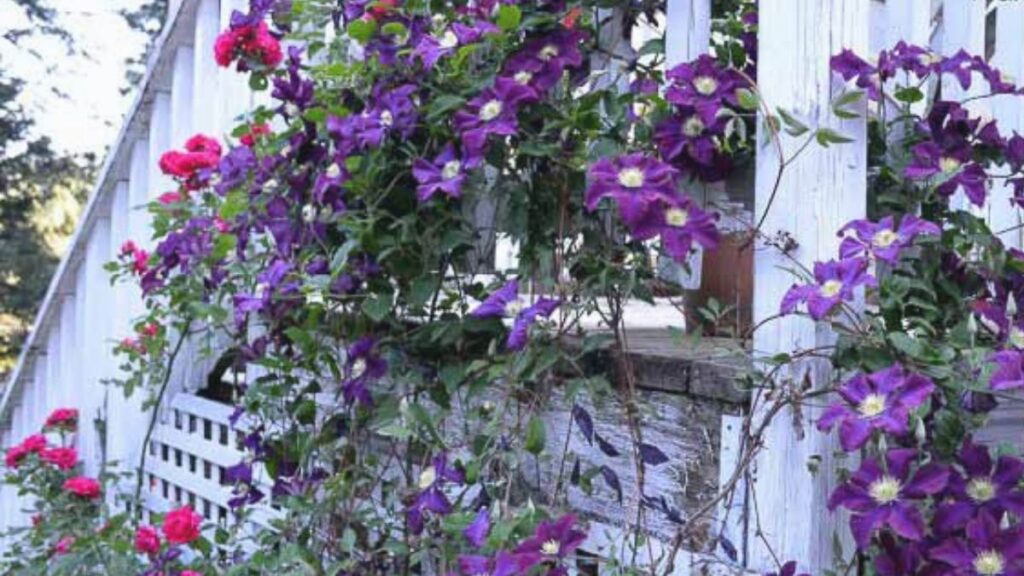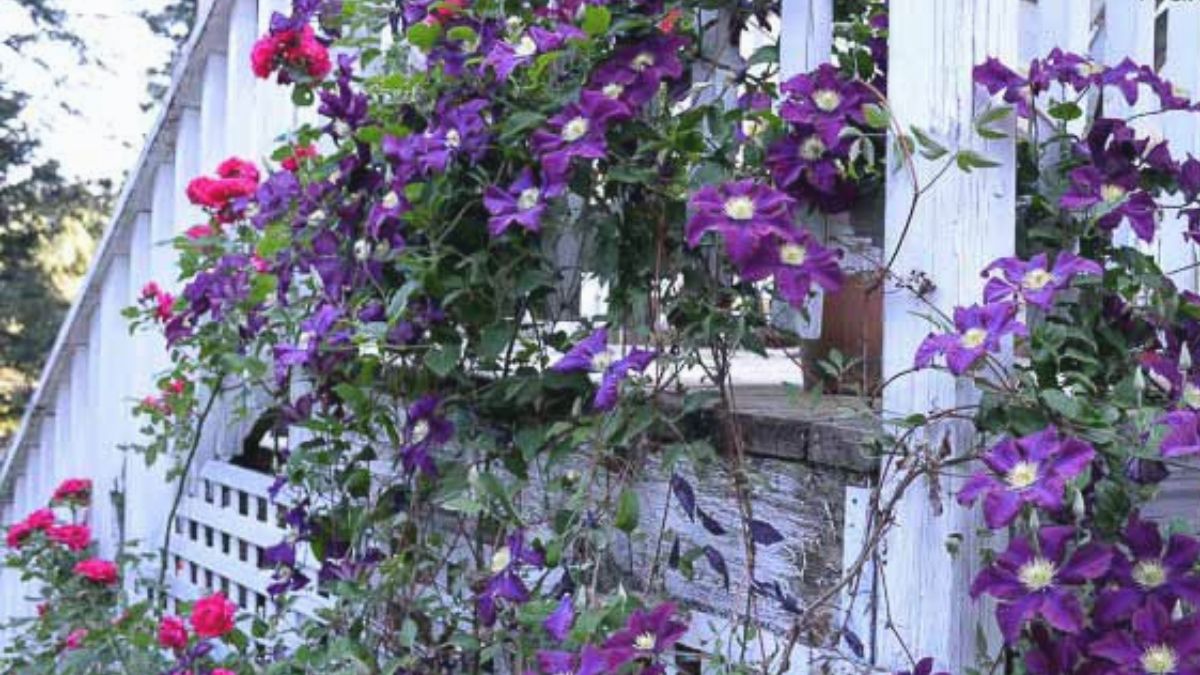Looking to add a touch of elegance to your home? Why not try growing a clematis vine! This flowering plant is easy to care for and can add a beautiful splash of color to any garden or patio. Keep reading to learn how to grow clematis vine in your own home.
The clematis vine is a popular climbing plant that produces beautiful flowers in a variety of colors. Clematis vines are relatively easy to grow, and they make a great addition to any garden. With proper care, your clematis vine will flourish and produce an abundance of flowers for many years to come.

There are hundreds of different varieties of clematis plants, so you can choose the one that best suits your needs. Some varieties are better suited for shady areas, while others do well in full sun. There are also dwarf varieties that only grow to a few feet in length, as well as sprawling varieties that can reach up to 30 feet or more.
When you’re ready to plant your clematis vine, be sure to choose a location that gets at least six hours of sunlight per day. The vine will also need a support structure to climb on, so be sure to choose one that is strong and sturdy. A trellis or fence makes a good support structure for a clematis vine.
Once you have chosen the perfect spot for your plant, it’s time to start planting. Clematis vines prefer loose, well-draining soil with plenty of organic matter. You can improve the drainage of your soil by adding some sand or perlite before planting. It’s also a good idea to mix in some slow-release fertilizer before planting to give your vine a boost.
To plant your clematis vine, dig a hole that is twice as wide as the root ball and just as deep. Gently remove the plant from its pot and place it in the hole so that the roots are covered with soil. Backfill the hole with soil and water deeply until the ground is saturated. Be sure not to overwater your plant, as this can lead to root rot.
Once your plant is in the ground, give it a light pruning to encourage new growth. You can also add a layer of mulch around the base of the plant to help retain moisture and keep weeds at bay
What is Clematis?
Clematis is a genus of about 300 species within the buttercup family Ranunculaceae. Their garden hybrids have been popular among gardeners since the 19th century. Many police officers in the United Kingdom wear clematis as a symbol of service, as it is also known as ” Our Lady’s garment”.
The Different Types of Clematis
There are many different types of clematis, but they can be broadly classified into two groups: herbaceous and woody.
Herbaceous clematis include:
Alpine clematis: A small, low-growing plant with white or purple flowers. Can be difficult to grow in hot climates.
Climbing clematis: A vigorous climber with large flowers, available in a range of colors including white, purple, and pink.
Early large-flowered clematis: A vigorous climber with large flowers, available in a range of colors including white, purple, and pink. Flowers appear early in the season.
Florist’s clematis: A small plant with fragile stems, often grown as an annual. Flowers are available in many colors including white, purple, blue, and pink.
Ground cover clematis: A spreading plant that is used to cover large areas of ground. Flowers are generally small and not showy. Available in a range of colors including white, purple, and pink.
Woody clematis include:
Japanese clematis: A woody climber with small flowers that are often fragrant. Available in a range of colors including white, purple, blue, and pink.
Montane clematis: A woody climber with inconspicuous flowers that is native to mountain regions. Often used as an ornamental plant in gardens.
Vine clematis: A woody vine with large flowers that is related to the climbing clematis but does not climb as high
Where to Plant Clematis
Choosing the right spot to plant your clematis vine is important to ensure that it will thrive. Ideally, you should choose a location that receives at least six hours of sun per day. However, if you live in an area with very hot summers, it’s best to choose a spot that gets afternoon shade.
When it comes to soil, clematis vines prefer rich, well-drained soil that is high in organic matter. If your soil is poor or sandy, you can improve it by adding compost or other organic matter. It’s also a good idea to amend the soil with a slow-release fertilizer before planting.
How to Plant Clematis
Clematis are fast-growing vines that will quickly cover an unsightly wall or fence, or provide welcome shade in a hot summer garden. They come in many colors, shapes and sizes, and with a little planning, you can have blooms from early spring until fall.
To get the most out of your clematis, it’s important to plant them correctly. Follow these tips and you’ll be rewarded with many years of beautiful blooms.
Choose a location that gets at least six hours of sun per day. Clematis will grow in partial shade, but they won’t bloom as profusely.
Prepare the planting bed by using a shovel or tiller to loosen the soil to a depth of 12 inches. Add compost or other organic matter to the bed before planting. This will help improve drainage and provide nutrients for your clematis.
Dig a hole that is large enough to accommodate the roots of your plant without crowding them. The hole should be about 18 inches deep.
Carefully remove your plant from the pot it came in and spread the roots out in the hole. The crown of the plant (where the stem meets the roots) should be about 2 inches below the soil surface. Backfill with soil and water deeply to settle the roots into their new home.
How to Care for Clematis
Clematis vines are fast-growing, flowering plants that can add beauty and elegance to any landscape. These vigorous climbers can reach heights of 20 feet or more, making them perfect for covering walls, trellises, and arbors. Clematis are relatively easy to care for and are low-maintenance once they are established. With a little effort, you can have a beautiful clematis vine in your garden in no time!
There are a few things to keep in mind when caring for your clematis vine:
-Clematis prefer full sun to partial shade and well-drained soil.
-Water regularly, especially during dry spells.
-Fertilize in early spring and again in mid-summer with a balanced fertilizer.
Pruning is also important for keeping your clematis healthy and vigorous. Light pruning should be done in late winter or early spring to shape the plant. Heavy pruning should be done after the plant has flowered in the summer. With proper care, your clematis vine will thrive and provide you with years of enjoyment!
Pruning Clematis
late spring after it blooms. If it blooms in the spring on last year’s growth, wait to prune until
Troubleshooting Clematis
As beautiful and simple as they are to grow, clematis vines can be susceptible to a few problems. Aphids, scale, spider mites, and borers are the most common pests. These pests can cause stunted growth, leaf curling, and even death.
Pruning is the best way to keep your clematis healthy and free of pests. Begin pruning in late winter or early spring, before new growth begins. Cut back all of the previous year’s growth to about 6 inches. This will encourage new growth that is less likely to be infected with pests.
If you do find pests on your plant, you can treat them with insecticidal soap or horticultural oil. Be sure to follow the instructions on the label carefully.
With a little care, your clematis vine will be a beautiful addition to your garden for years to come!

